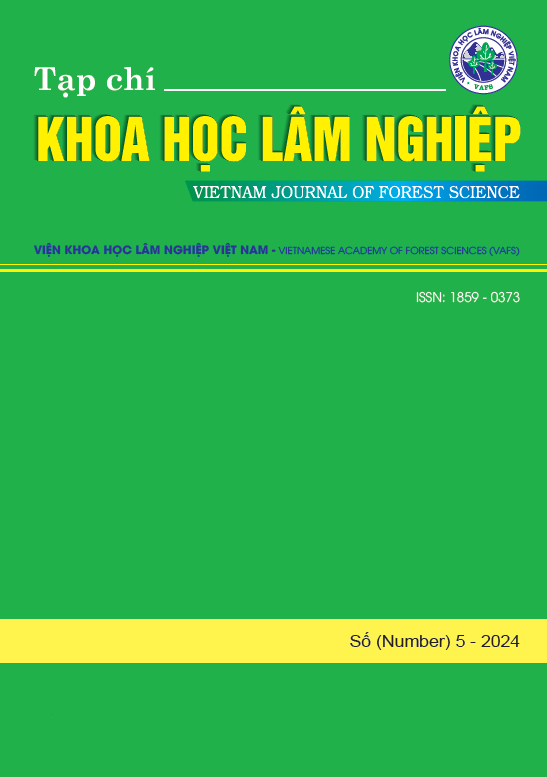Some characteristics of natural forest structure where have (Toona sureni (Blume) Merr.) in Dien Bien and Son La
DOI:
https://doi.org/10.70169/VJFS.943Keywords:
Toona surenii (Blume) Merr., Forest structure, Dien Bien, Son LaAbstract
Toona surenii (Blume) Merr. is a large timber species with high yield and good quality wood that has been heavily exploited. In order to contribute to the conservation and development of this species, the article provides results of research on the structural characteristics of natural forests where Toona surenii (Blume) Merr. species is distributed in Dien Bien and Son La provinces. The article used survey method on 6 transects and studied on 18 typical sample plots, temporarily with an area of each sample plot of 2,500m2 in the state of poor forest, very poor forest and medium forest. The results show that the density of the upper layer of trees is quite low, only 124 - 267 trees/ha, while the density of Toona surenii (Blume) Merr. is from 12 - 29 trees/ha. The research area is quite diverse with many different species, ranging from 30 - 48 species, of which 6 - 7 species participate in the composition formula according to the IV% index. Toona surenii (Blume) Merr. IV% index ranges from 9.34 - 15.97%. The canopy structure has 3 main layers, the number of trees in the forest stand is mainly concentrated in the main canopy layer (84 - 184 trees/ha), Toona surenii (Blume) Merr. is mainly distributed in the main canopy layer and the dominance layer; The average canopy cover is from 0.45 - 0.7. The distance function is most suitable to simulate the distribution of tree numbers according to diameter class and the Weibull function is the most suitable to simulate the distribution of tree number according to height class. In nature, Toona surenii (Blume) Merr. is often accompanied by a number of species such as Castanopsis, Bischofia javanica, Paramichelia baillonii (Pierre) S.Y.Hu, Cinnamomum balansae Lecomte, Choerospondias axillaris (Roxb.) Burtt. & Hill, Keteleeria evelyniana,... These species should be chosen for mixed planting or to enrich the forest with Toona surenii (Blume) Merr. species.
References
Bảo Huy, 1997. Nghiên cứu một số đặc điểm sinh thái và sinh trưởng loài cây bản địa Xoan mộc (Toona Sureni (B1.) Moore) làm cơ sở tổ chức kinh doanh tại lâm trường Quảng Tân, huyện Đắk RLắp, Đắk Lắk, Báo cáo khoa học, Trường Đại học Tây Nguyên.
Bảo Huy, 2002. Cây Xoan mộc. Sách sử dụng cây bản địa vào trồng rừng ở Việt Nam, Nhà Xuất bản Nông nghiệp, trang 183- 187.
Chen Dong and Cui Tonglin, 2010. Utilization Value and Cultivation Techniques of Toona sureni, Forest By-Product and Speciality in China.
Nguyễn Hải Tuất, Vũ Tiến Hình, Ngô Kim Khôi, 2006. Phân tích thống kê trong lâm nghiệp, NXB Nông nghiệp, Hà Nội.
Trần Hữu Biển, 2015. Nghiên cứu chọn giống và kỹ thuật trồng rừng thâm canh cây Lò bo (Brownlowia tabularis Pierre), Xoan mộc (Toona surenii (Blume) Merr.) và Dầu cát (Dipterocarpus condorensis Ashton.) tại một số vùng sinh thái trọng điểm, Báo cáo tổng kết đề tài cấp Bộ, Viên Khoa học Lâm nghiệp Việt Nam.
Thông tư 16/2023/TT-BNNPTNT ngày 15/12/2023 sửa đổi một số điều thông tư 33/2018/TT-BNNPTNT ngày 16/11/2018 quy định về điều tra, kiểm kê theo dõi diễn biến rừng.









